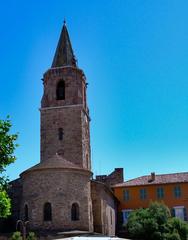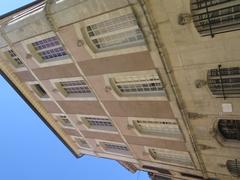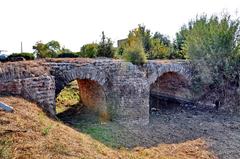Musée Archéologique de Fréjus: Visiting Hours, Tickets, and Complete Guide to Fréjus Historical Sites
Date: 03/07/2025
Introduction
Situated in the heart of Fréjus, a city with a rich Roman legacy, the Musée Archéologique de Fréjus offers visitors an in-depth exploration of the ancient world of Forum Iulii. Established in the late 19th century, the museum preserves and displays an extensive collection of Roman artifacts discovered in Fréjus and its surroundings. With its central location near other major historical landmarks—such as the Roman amphitheater and the Cathedral of Saint-Léonce—the museum is a must-visit for anyone looking to dive into Provence’s fascinating past.
This comprehensive guide covers everything you need to know before visiting the Musée Archéologique de Fréjus: its history, notable collections, visiting hours, ticket options, accessibility, events, and practical tips for exploring Fréjus historical sites. Whether you’re an archaeology enthusiast or a casual visitor, you’ll find essential information to make your trip memorable.
Table of Contents
- Introduction
- Historical Background of the Museum
- Fréjus: A Roman City and Its Archaeological Legacy
- Key Collections and Notable Artifacts
- Practical Visitor Information: Hours, Tickets, Accessibility
- The Museum’s Role in Local Heritage and Education
- Events, Temporary Exhibitions, and Special Tours
- Exploring Other Fréjus Historical Sites
- Visitor Tips and Frequently Asked Questions (FAQ)
- Conclusion and Call to Action
- References
Historical Background of the Museum
The Musée Archéologique de Fréjus originated in the late 19th century during a period of heightened archaeological interest in southern France. Local antiquities collector J.A. Aubenas was instrumental in assembling a significant collection, which formed the basis of the museum when it was officially recognized in 1882. The growing collection prompted a move to the Salle de l’Officialité within the Palais Episcopal in 1912, and further expanded following systematic excavations by Dr. Donnadieu in the 1930s. Post-World War II, the museum’s holdings were further enriched with significant finds, such as the Pelloux-Gervais collection (Gralon). Today, the museum is located in Vieux Fréjus, adjacent to the cathedral, serving as a guardian of the city’s ancient heritage.
Fréjus: A Roman City and Its Archaeological Legacy
Fréjus, known as Forum Julii in antiquity, was founded by Julius Caesar in 49 BCE as a strategic Mediterranean port and naval base. The city thrived under Roman rule, becoming a hub for trade and military operations. Its prominence is evidenced by the remains of a large amphitheater, a theater, and a 40-kilometer aqueduct system. Ongoing archaeological research continues to reveal layers of urban development, with the museum’s collection providing valuable insights into the evolution of daily life, religion, and art from the Roman era through the medieval period (France-Voyage; The Crazy Tourist; Archaeology Travel).
Key Collections and Notable Artifacts
The museum’s collection is renowned for its diversity and preservation. Highlights include:
- Hermès Bicéphale (Double-Headed Hermès Bust): A marble sculpture that has become an emblem of Fréjus, celebrated for its craftsmanship and unique double-faced design (Archaeology Travel; The Crazy Tourist).
- Mosaic of the Panther: An intricately detailed floor mosaic illustrating Roman artistic sophistication.
- Funerary Artifacts: Steles, urns, and grave goods that shed light on Roman burial practices.
- Domestic Items: Pottery, lamps, and tools reflecting everyday life in ancient Fréjus.
- Sculptures and Architectural Fragments: Statues and decorative elements from public and private buildings.
- Maquette of Forum Iulii: A scale model reconstructing the city’s ancient layout, enhancing visitor understanding.
These pieces are displayed thematically, guiding visitors through Roman urbanism, religion, domestic life, and funerary customs.
Practical Visitor Information: Hours, Tickets, Accessibility
Visiting Hours
- October 1 – March 31:
Tuesday to Saturday, 9:30 am – 12:00 pm and 2:00 pm – 4:30 pm. Closed on Sundays, Mondays, and public holidays. - April 1 – September 30:
Tuesday to Sunday, 9:30 am – 12:30 pm and 2:00 pm – 6:00 pm. Closed on Mondays and public holidays. - Special Events:
Extended hours during European Archaeology Days and the European Night of Museums (Guide Tourisme France).
Always confirm current hours via the Fréjus Tourist Office or Esterel Côte d’Azur tourism site.
Ticket Prices and Passes
- Single Entry: €3 per person (includes permanent and temporary exhibits).
- Fréjus Pass: €6, access to four major heritage sites over seven days.
- Fréjus Pass Intégral: €9, includes five sites and the cloister.
- Reduced Rate: €4 for students, seniors, and eligible groups.
- Free Entry: For children under 18, EU residents under 26, and on certain occasions (e.g., European Night of Museums).
Tickets are available on-site and sometimes online (Guide Tourisme France).
Accessibility
- Wheelchair Access: The museum is wheelchair accessible in most areas, with ramps and adapted restrooms. However, some older sections may have limited access.
- Assistance: Staff can provide help to visitors with reduced mobility; service animals are welcome.
Getting There
- Address: Place Calvini, 83600 Fréjus, France.
- By Train: 1.5 km from Fréjus station.
- By Car: Parking Paul Vernet is a 3-minute walk away.
- By Bus/Foot: Central location, easily accessible by public transport and on foot from city landmarks.
The Museum’s Role in Local Heritage and Education
A “Musée de France” and part of the “Villes et Pays d’art et d’histoire” network, the museum is at the forefront of heritage preservation and public education. It works with archaeologists, local authorities, and academic institutions to document, conserve, and interpret the region’s rich history. Educational workshops, temporary exhibitions, and guided tours deepen public engagement, and the museum regularly integrates new discoveries into its displays (Fréjus Tourist Office).
Events, Temporary Exhibitions, and Special Tours
Temporary Exhibitions
- Current Theme (January–June 2025):
“Un brin de… Forum Iulii et la mer”—exploring the port city’s relationship with the sea through rare artifacts and the latest discoveries (Ville de Fréjus brochure).
Annual and Special Events
- European Archaeology Days (June 13–15, 2025):
Special guided tours, excavation presentations, and family activities. - European Night of Museums (May 17, 2025):
Free evening admission, live performances, and storytelling. - Workshops:
Antique sports, mosaic and pottery creation, and ancient cooking demonstrations. - Special Guided Tours:
Combined visits with the Roman Fishpond Crypt—advance reservation recommended (Fréjus Official).
Check the museum’s official website for updates.
Exploring Other Fréjus Historical Sites
Enhance your visit by exploring nearby heritage sites, many included in the Fréjus Pass:
- Roman Amphitheater: One of the best-preserved in southern France (The Crazy Tourist).
- Aqueduct: Remnants can be seen within the city and countryside.
- Episcopal City: Includes the cathedral, cloister, and baptistery (France-Voyage).
- Musée des Troupes de Marine & Musée d’Histoire Locale: Exploring Fréjus’s military and local history (Musée du Patrimoine).
Visitor Tips and Frequently Asked Questions (FAQ)
Tips for a Memorable Visit
- Plan in Advance: Check current hours, ticketing, and events.
- Combine Visits: Use the Fréjus Pass for value and access to multiple sites.
- Photography: Non-flash photos are generally permitted.
- Language: Most exhibits are in French; English materials are often available.
- Duration: Allocate 1–1.5 hours for the museum; more if attending guided tours.
- Climate: The museum is air-conditioned—ideal year-round.
FAQs
Q: What are the Musée Archéologique de Fréjus visiting hours?
A: Hours vary by season; generally Tuesday–Sunday, 10:00 AM–6:00 PM. Confirm before visiting.
Q: How much are tickets?
A: Standard entry is €3; discounts and passes are available.
Q: Is the museum wheelchair accessible?
A: Most areas are accessible; some older sections may have limited access.
Q: Are guided tours available in English?
A: Tours are mainly in French; inquire about English options in advance.
Q: Can I combine my visit with other sites?
A: Yes, the Fréjus Pass includes several key historical landmarks.
Conclusion and Call to Action
The Musée Archéologique de Fréjus is an essential gateway to understanding the city’s Roman roots and its ongoing archaeological story. With its exceptional collections, educational mission, and central location, the museum offers a rewarding and accessible experience for all. Enhance your visit by exploring nearby historical sites, participating in events, and using the Audiala app for interactive guides.
Start planning your journey into the ancient world of Provence by consulting official resources, booking your tickets, and following the museum and Fréjus Tourist Office on social media for the latest updates.
References and Further Reading
- Musée Archéologique de Fréjus (Gralon)
- Fréjus Tourist Office
- Esterel Côte d’Azur Tourism Site
- Guide Tourisme France
- France-Voyage
- The Crazy Tourist
- Archaeology Travel
- Ville de Fréjus Brochure
- Musée du Patrimoine
- Provence Lovers



